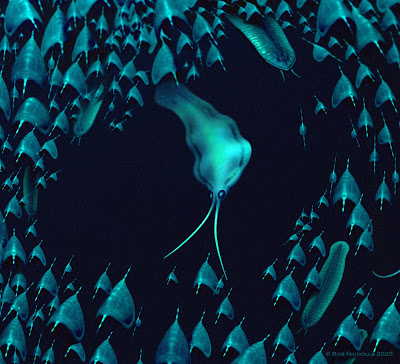 |
| Nektognathus evasmithae Vinther, Parry, Lee, Nielsen, Oh, C. Park, Kihm, DeVivo, Harper, Nielsen & T.-Y. S. Park, 2025 Artwork by Robert Nicholls |
Abstract
Nectocaridids are enigmatic Palaeozoic animals with a controversial phylogenetic position. Previous hypotheses have placed them in their own phylum, chordates, molluscs (specifically cephalopods), or radiodont panarthropods. We describe here a nectocaridid, Nektognathus evasmithae gen. et sp. nov. from the early Cambrian (~519 million years) Sirius Passet Lagerstätte of North Greenland. Key specimens preserve paired, phosphatized arcuate structures consistent with preservation of a ventral ganglion, a feature characteristic of extant and fossil chaetognaths, including the amiskwiid Timorebestia koprii also from Sirius Passet. Nektognathus shares a gnathostomulid-like jaw apparatus, lateral fins, subterminal anus, and large antennae with Timorebestia and Amiskwia, placing nectocaridids in the chaetognath stem lineage. The complex sensory anatomy of nectocaridids, which is partially shared with other extinct amiskwiids, highlights a more dynamic predatory lifestyle much higher in the trophic food chain during early chaetognath evolution.
Systematic Paleontology
Spiralia Schleip, 1929
Chaetognathifera Bekkouche and Gąsiorowski, 2022
Phylum Chaetognatha Leuckart, 1854 (stem group)
Family Nectocarididae Conway Morris, 1976
Diagnosis: Dorsoventrally flattened bilaterian with lateral fins supported by fin rays. The body is divided into a distinct head and trunk. The head is narrow and bears long frontal antennae and a pair of large, lateral eyes of camera type. A jaw apparatus flanks the digestive tract in the anteriormost part of the trunk, consisting of a bilateral set of very large, subtriangular elements and a basal, anterior, median plate. The tubular gut terminates subterminally anterior to the posterior fin region. Diagnosis was emended from Conway Morris (1976).
Genera included: Nectocaris Conway Morris 1976, Nektognathus gen. nov.
Genus Nectocaris Conway Morris 1976
Genus Nektognathus evasmithae gen. et sp. nov.
Locality and horizon: The material was collected at locality 1 in Sirius Passet, 82°47.6′N, 42°13.7′W, Peary Land, North Greenland.
Etymology: Nekto (Gr) for swimming and gnatha (Gr) meaning jaw. The species name is for Professor Emeritus Eva Smith in recognition of her enduring fight for impartial justice for everyone and holding politicians accountable.
Diagnosis for species and genus: Nectocaridid with distinct, caudal fin-region lacking fin rays. The eye stalks are short or absent. Ventral ganglion forms distinct arcuate structures in the midbody that is ~25% the length of the trunk.
Jakob Vinther, Luke A. Parry, Mirinae Lee, Morten Lunde Nielsen, Yeongju Oh, Changkun Park, Ji-Hoon Kihm, Giacinto DeVivo, David A. T. Harper, Arne T. Nielsen and Tae-Yoon S. Park. 2025. A fossilized ventral ganglion reveals a chaetognath affinity for Cambrian nectocaridids. Science Advances. 11(30); DOI: doi.org/10.1126/sciadv.adu6990 [23 Jul 2025]
